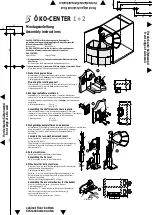
RM3000-f & RM2000-f Sensor Suite User Manual
– August 2012
Page 23 of 42
4.2 Layout
4.2.1 Sensor Orientation
Figure 4-3 indicates how the three geomagnetic sensors in a RM3000-f Suite should be
oriented for a system referenced as north-east-down (NED). The arrow represents the
direction of travel or pointing. Positioning of the sensors is not critical, other than
ensuring they are not positioned close to a magnetic component, such as a speaker. The
Sen-XY-f is insensitive to the location of the polarity indicator, while the location of the
polarity indicator is critical for the Sen-Z-f.
Figure 4-3: RM3000-f North-East-Down (NED) Sensor Layout
If the Sen-Z-f sensor is flipped to the bottom of the board such that the curved portion of
the sensor still points forward, then to retain NED the Sen-Z-f’s ZDRVN and ZDRVP
pads should be as shown above, except on the bottom of the board. As the pads on the
Sen-Z-f have switched positions, the connections to the Sen-Z-f sensor will be reversed.
4.2.2 Local Magnetic Field Considerations
Because the sensors measure magnetic field, it is important to consider what items in the
vicinity of the sensors can affect the sensor readings. Specifically:
The sensors have a linear regime of 200 T. (Earth’s field is ~50 T.) To
ensure the sensors operate in their linear regime, do not place the sensors close to
large electric currents, large masses of ferrous material, or devices incorporating
permanent magnets, such as speakers and electric motors.
Locate the sensors away from changing magnetic fields. While it is possible to
calibrate the sensors to accommodate local magnetic distortion that is fixed
relative to the sensors, changing local magnetic fields generally cannot be
accommodated. When the local magnetic field will change, try to take readings
















































